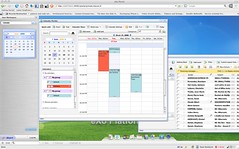We are all badly impacted with the price of oil. Yeah it really expensive,
now people is the US have a gas that is as expensive as France's
prices, shocking! ;).
Anyway, I do not want to talk about cars and gas, but really on the
good effect of the expensive oil. I do believe that expensive oil has
good impacts, not for my bank account but for the "planet", and may be
indirectly for software industry.
Change in transportation
First of all, we are all forced to try to save gaz/enegy to save money. So people are thinking more about alternative to "individual car driving": carpooling, public
transportations are more often used these days. I
addition, people are using public bikes that you can find
more and more in cities now. Nantes, where I live has launched its new
program "
Bicloo". So not only people are changing
but I am sure industrials will also adapt to this offering greener
alternative to oil for transportation. Personally, I would like to buy
a cheap
electric car to be able to go in the city, at least to reach the
various
Park&Ride points. I have to say that I really like the
Google RecharcheIT initiative, that is used to charge plug-in
hybrid cars... This is enough for the "transportation" and cars....
Change in way we do work
I believe also that expensive oil will have an impact on the way we do
work: we must try to avoid traveling all the time. Some work could be
done just using the Internet and good collaborative tools. When most of
a work is about: reading mail, phone talks, and meetings all these
activities could be done using "IT" isn't?
I used to work from home a lot when I was working for Oracle HQ from
France: the working kit is quite simple and not that expensive: laptop,
fast Internet connection, VoIP phone, VPN and a Collaborative
Suite (webmail, shared calendar, web conference tools, social networks,
...). Using this
simple set of tools I was as productive as any employee but without
traveling that much. I do not say that we should all work from home or
smal local office, but we should try to do it. And limit our endless
travels, that burns so much energy for CO2.... Yes all the IT is also
consuming energy, but I do believe that it is probably easy to make IT
industry "greener" than car industry... (I might be wrong...), but
still at the office we will use computers/IT anyway..
So many of the software vendor are offering tools to make us more
productive using the "network as the computer" -we all remember this-.
One example of tools that in fact is "greener" is
eXo
Platform. eXo provides all the tools for collaborative work:
personalized portal, webmail, chat, shared calendar, ... and soon
LiveRoom that is the Web conference/VoIP solution integrated to your
navigator (Flex based application). In addition to this, users can also
virtualized their desktop using eXo WebOS, and access his work
environment from everywhere... I know that other solutions are
available on the market, from various vendors such as Oracle, IBM,
Microsoft, I have chosen eXo first of all it is an open source project
where any user can participate at least by asking from requirements
proposing ideas, but also and mainly because its offering is based on
industry standards that will help integration to any existing IT
systems. (... and also because I am currently working closely with the
eXo team...)
IT for a greener world
In conlusion, we, IT folks can I have some impact on the environment by
helping people to be more effective when doing remote work, avoiding
useless commute... Clearly, the technologies are avaiable today to help
us, to work efficiently from home or "virtual offices" the main
constraints are coming from enterprise/management culture.







 Andres and Guillaume have posted on the Groovy Users list the pointers to many (if not all) the Groovy and Grails sessions of JavaOne 2008... You want to learn more, this is a great opportunity to do it so:
Andres and Guillaume have posted on the Groovy Users list the pointers to many (if not all) the Groovy and Grails sessions of JavaOne 2008... You want to learn more, this is a great opportunity to do it so:



 I have just created a poll -see leftbar- asking to list the different tools you are using for business. In fact I would like to have some feedback of you use of Wiki, Blogs, Instant Messaging on you daily job.
I have just created a poll -see leftbar- asking to list the different tools you are using for business. In fact I would like to have some feedback of you use of Wiki, Blogs, Instant Messaging on you daily job.